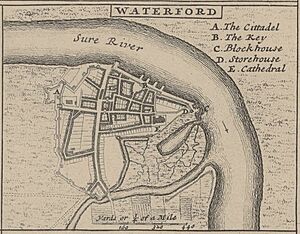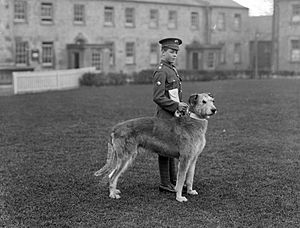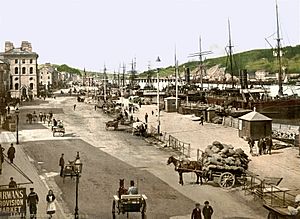History of Waterford facts for kids
Waterford city is in the southeast of Ireland. It sits on the River Suir, about 17 miles (27 km) from where the river meets the sea.
Waterford is Ireland's oldest city. It was likely started by Vikings in the 800s. Later, in the 1100s, Anglo-Normans took control. It became a very important city in medieval Ireland. Over time, Waterford has faced many challenges and changes. Today, it is still the biggest city in Ireland's southeast.
Contents
Waterford's Viking Beginnings
Waterford was founded by Vikings. People believe the city officially started in 914 AD. Vikings were living in the area even earlier, around 860 AD.
One popular story says a Viking leader named Sitric founded Waterford in 853. Another tale suggests that the Norwegian King Harald Finehair founded Dublin and gave Waterford to his brother.
A famous Viking leader of Waterford was Ivar of Waterford, who died in 1000 AD. Later, powerful Irish kings like Brian Bóruma took control of Viking ports like Waterford. This helped them gain more power and access to trade.
Anglo-Norman Arrival and Medieval Times
In 1137, Diarmuid MacMurrough, the King of Leinster, tried to capture Waterford but failed. He wanted to control important cities to become the High King of Ireland.
In 1170, MacMurrough teamed up with Strongbow. Together, they attacked and took Waterford after a tough fight. This event brought the Anglo-Normans to Ireland.
In 1171, Henry II of England arrived in Waterford with a large fleet. He wanted to make sure Ireland became an English colony. Waterford and Dublin were made royal cities, belonging directly to the king. Dublin became the capital of Ireland.
During the Middle Ages, Waterford was Ireland's second most important city, after Dublin. The city's "Great Parchment Book" from 1361 to 1649 shows the earliest official use of the English language in Ireland.
Religious Conflicts and Changes
In 1603, during the Nine Years' War (Ireland), English forces led by Mountjoy occupied Waterford. This war was a rebellion led by Hugh O'Neill, Earl of Tyrone, who fought for Irish independence and the Catholic religion.
Even though most people in Waterford were Catholic, they mostly supported the English government. However, when James VI became King of England in 1603, the citizens of Waterford joined an uprising. They refused to let Mountjoy, the king's representative, into the city.
The people of Waterford wanted freedom to practice their Catholic religion. Catholic priests led them, and they reopened several churches. After some talks, Mountjoy was allowed into the city, and the citizens promised their loyalty again.
Over the next 40 years, many Catholics in Waterford felt separated from the English Protestant government. After the Irish Rebellion of 1641, Waterford became a strong supporter of the Confederate Catholics of Ireland. This group was an independent Irish state that fought for Irish Catholic interests.
Waterford was known for its strong Catholic beliefs. The city even rejected a deal between the Confederates and King Charles I. This deal would have sent Irish troops to fight for the King in the English Civil War.
Prosperity in the 1700s and 1800s

The 1700s were a very successful time for Waterford. Many of the city's beautiful buildings were built then. Trading with Newfoundland brought a lot of money to Waterford. At that time, it was the third largest port in Ireland.
In 1783, George and William Penrose started a glass factory. This factory became Waterford Crystal, which is now the city's most famous business.
A military base, the Cavalry Barracks, was built in the city at the end of the 1700s.
In the 1800s, industries like glass making and shipbuilding grew in Waterford. Thomas Francis Meagher, an Irish nationalist, brought the first Irish tricolour flag back from France. It was first flown from a building in Waterford.
Waterford in the 1900s
In the early 1900s, John Redmond was a Member of Parliament for Waterford. He led the Irish Parliamentary Party. This party almost achieved "Home Rule," which would have given Ireland its own parliament.

Irish Civil War in Waterford
After British troops left Waterford city at the end of the Irish War of Independence, Irish fighters took over the military and police buildings. These fighters were led by George Lennon and Pax Whelan. They were against the Anglo-Irish Treaty of 1922. Because of this, they joined the Republican side when the Irish Civil War began in June 1922.
Republicans saw Waterford as a key stronghold in the "Munster Republic." In late July 1922, the National Army arrived to take back the city. Their troops had artillery and machine guns.
The Republicans tried to defend the city from the south bank of the River Suir. They held the military barracks, the prison, and the Post Office. The National Army placed their artillery on Mount Misery, which overlooked the Republican positions. They bombed the Republicans until they had to leave the barracks and prison.
The National Army then moved their gun closer to force the Republicans out of the Post Office. Some street fighting followed. The Republican fighters then left the city and went west. Two National Army soldiers and one Republican fighter were killed in the fighting. Five civilians also died.


